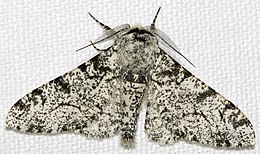

The evolution of the peppered moth is an evolutionary instance of directional colour change in the moth population as a consequence of air pollution during the Industrial Revolution. The frequency of dark-coloured moths increased at that time, an example of industrial melanism. Later, when pollution was reduced, the light-coloured form again predominated. Industrial melanism in the peppered moth was an early test of Charles Darwin's natural selection in action, and it remains a classic example in the teaching of evolution.[1][2][3] In 1978, Sewall Wright described it as "the clearest case in which a conspicuous evolutionary process has actually been observed."[4][5]
The dark-coloured or melanic form of the peppered moth (var. carbonaria) was rare, though a specimen had been collected by 1811. After field collection in 1848 from Manchester, an industrial city in England, the frequency of the variety was found to have increased drastically. By the end of the 19th century it almost completely outnumbered the original light-coloured type (var. typica), with a record of 98% in 1895.[6] The evolutionary importance of the moth was only speculated upon during Darwin's lifetime. It was 14 years after Darwin's death, in 1896, that J. W. Tutt presented it as a case of natural selection.[7] Because of this, the idea spread widely, and more people came to believe in Darwin's theory.
Bernard Kettlewell was the first to investigate the evolutionary mechanism behind peppered moth adaptation, between 1953 and 1956. He found that a light-coloured body was an effective camouflage in a clean environment, such as in rural Dorset, while the dark colour was beneficial in a polluted environment like industrial Birmingham. This selective survival was due to birds, which easily caught dark moths on clean trees and white moths on trees darkened with soot. The story, supported by Kettlewell's experiment, became the canonical example of Darwinian evolution and evidence for natural selection used in standard textbooks.[8][9][10]
However, failure to replicate the experiment and Theodore David Sargent's criticism of Kettlewell's methods in the late 1960s led to general skepticism. When Judith Hooper's Of Moths and Men was published in 2002, Kettlewell's story was more sternly attacked, and accused of fraud. The criticism became a major argument for creationists. Michael Majerus was the principal defender. His seven-year experiment beginning in 2001, the most elaborate of its kind in population biology, the results of which were published posthumously in 2012, vindicated Kettlewell's work in great detail. This restored peppered moth evolution as "the most direct evidence", and "one of the clearest and most easily understood examples of Darwinian evolution in action".[11]
- ^ Cook, L. M.; Saccheri, I J (March 2013). "The peppered moth and industrial melanism: evolution of a natural selection case study". Heredity. 110 (3): 207–212. doi:10.1038/hdy.2012.92. PMC 3668657. PMID 23211788.
- ^ Rudge, David W. (2005). "The Beauty of Kettlewell's Classic Experimental Demonstration of Natural Selection". BioScience. 55 (4): 369–375. doi:10.1641/0006-3568(2005)055[0369:TBOKCE]2.0.CO;2.
- ^ Majerus, Michael E. N. (2008). "Industrial Melanism in the Peppered Moth, Biston betularia: An Excellent Teaching Example of Darwinian Evolution in Action" (PDF). Evolution: Education and Outreach. 2 (1): 63–74. doi:10.1007/s12052-008-0107-y. S2CID 25407417.
- ^ Rice, Stanley A. (2007). Encyclopedia of Evolution. New York: Facts on File. p. 308. ISBN 978-1-4381-1005-9.
- ^ Majerus, Michael E. N. (1998). Melanism: Evolution in Action. Oxford University Press. ISBN 978-0-19-854983-3.
- ^ Clarke, C. A.; Mani, G. S.; Wynne, G. (1985). "Evolution in reverse: clean air and the peppered moth". Biological Journal of the Linnean Society. 26 (2): 189–199. doi:10.1111/j.1095-8312.1985.tb01555.x.
- ^ Majerus, Michael E. N. (2008). "Industrial Melanism in the Peppered Moth, Biston betularia: An Excellent Teaching Example of Darwinian Evolution in Action". Evolution: Education and Outreach. 2 (1): 63–74. doi:10.1007/s12052-008-0107-y.
- ^ Bender, Eric (21 March 2022). "Urban evolution: How species adapt to survive in cities". Knowable Magazine. Annual Reviews. doi:10.1146/knowable-031822-1.
- ^ Diamond, Sarah E.; Martin, Ryan A. (2 November 2021). "Evolution in Cities". Annual Review of Ecology, Evolution, and Systematics. 52 (1): 519–540. doi:10.1146/annurev-ecolsys-012021-021402. S2CID 239646134.
- ^ Miller, Ken (1999). "The Peppered Moth - An Update". www.millerandlevine.com. Retrieved 31 March 2022.
- ^ Cook, L. M.; Grant, B. S.; Saccheri, I. J.; Mallet, James (2012). "Selective bird predation on the peppered moth: the last experiment of Michael Majerus". Biology Letters. 8 (4): 609–612. doi:10.1098/rsbl.2011.1136. PMC 3391436. PMID 22319093.